

Full-day country walks in
SE England and beyond
Berwick to Seaford
Click on the image below to access
the full map on plotaroute
Distance: 14 miles.
Time without long breaks: Apx 7 hours (add time for lunch/pubs).
Terrain: There are some fairly steep climbs – including up Windover Hill and the steps from West Dean to Exceat but nothing too severe.
How to get there and back: Train to Berwick, return from Seaford. Buy a return ticket to Lewes and two singles.
Pubs: The Giant's Rest at Wilmington and the Eight Bells at Jevington are handily placed at the 3 and 6 miles mark, with the latter the obvious choice for a lunch break. Further on, there is the Cuckmere Pub at Exceat (an average pub, but it has some great views of the estuary from the seating out the back). There is also a selection of pubs in Seaford, including the Steamworks taproom and cafe at the station.
More information: If you are catching a train from London, you may need to change at Lewes to get on a train that stops at Berwick.
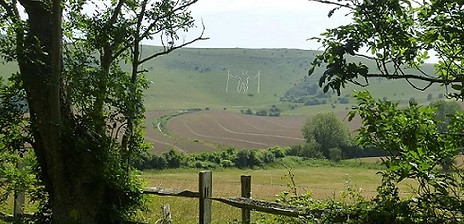
Following parts of the Wealdway, South Downs Way and Vanguard Way, this route includes beautiful Friston Forest and views of the Seven Sisters. The highlight is a climb up to the magnificent Long Man of Wilmington chalk hill figure (see panel below). Wilmington itself is a picturesque village with a ruined medieval priory. The final section takes you over the clifftops via a nature reserve to the small town of Seaford, which offers a number of eating and drinking options before the train home.
Turn left as you exit Berwick station. A few yards up on the right, just before the service station, look for a wooden footpath sign which points to a path that runs alongside a house. Go through a gate into a field. Following the well-marked path, you reach some swing gates where it heads uphill. It then turns sharply right at the top of the hill and leads to a gate. Head straight downhill, with the fence on your right and views of Arlington reservoir ahead. You reach a small gate leading on to a lane. Turn left. If you want to have a look at the reservoir, which is also a nature reserve, walk down the lane for 150m and then go through the gate on your right (the reservoir is also featured on walk 25).
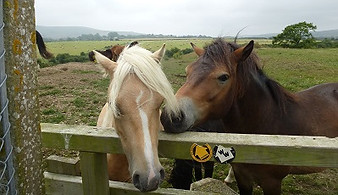
The path turns at right angles away from the river at the bottom of the field, before heading south again, with a farm on the left. It takes you to a railway crossing. Go over the tracks and keep on the Wealdway, following the edge of fields through a couple of gates, until it emerges at some farm buildings at Milton Gate and the busy A27. Take care crossing the road and take the lane opposite. You pass a farm drive on the left and a postbox on the right. A little further down, just before the first house on the lane, turn left by a wooden post. Follow this footpath, passing a nursery on the left and going through a small wood before reaching some houses and a lane that leads to Wilmington village.

There are fine views of the Long Man of Wilmington from here. To reach the hill figure, go through the gate and take the path up Windover Hill. The Long Man is one of only two human figures in the English landscape – the other being the Cerne Abbas Giant in Dorset. There is controversy over its date of origin – with theories ranging from the neolithic period to the 16th century (see panel below). Although it looks like it is carved in the chalk, it is composed of painted blocks. Climb further up to the brow of the hill where there is a long barrow and some tumuli. Just beyond, you will find a track running along the ridge. This is the South Downs Way.

On leaving the pub, return down the road. After passing the lane to the church, take the next right following the sign for the bridleway. Go over the cattle grid and head up the track. The path enters Friston Forest, an open-access woodland run by the Forestry Commission. It's easy to get lost here, but just follow the track ignoring the turnings left and right. The path briefly emerges from the trees to cross a field. Head over and re-enter the forest by a wooden gate. The track merges with another at Sheep Pen Cottages. Carry on until you come out at the village of West Dean. You will see the church on the right but take the left-hand fork. Follow the lane round and turn left at the village noticeboard.

Follow the right bank of river from the steps to the pub via the car park and go through the gate. You are now the Vanguard Way. The path runs along the edge of the flood plain, with the river down on your left, eventually reaching the sea by some coastguard cottages and a memorial to Canadian soldiers who camped here and were allegedly killed in an air raid in 1940 (although there appears to be no evidence of this incident actually taking place). This is a photogenic beauty spot, with great views across the Cuckmere estuary to the cliffs on the opposite side.

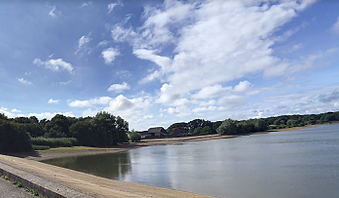
From the reservoir, head back down the lane the way you came, but after 100m take the stile on the left. Walk across the field in the same direction as the lane, aiming for some trees. Pass through the trees via the stiles and follow the path towards a stile onto the road, with a hedge to your right. When you reach the road, cross over and take the short footpath opposite through the woods. This emerges back at the lane. Turn right. After the blue railings of a bridge over the River Cuckmere, take the footpath on the right by the wooden signpost, joining the Wealdway long-distance footpath. The path follows the river south (word of warning – one of us was bitten by a grass snake here!).

Turn left when you reach the road and head down The Street to reach the Giant's Rest pub (a good place to rest for both giants and non-giants). On leaving the pub, head back the way you came, passing the lane that you came down. Wilmington has some really beautiful old houses and towards the end of The Street, on the right, you will come to the ruins of an 11th century Benedictine priory and the parish church of St Mary and St Peter. The churchyard contains a yew tree believed to be 1,600 years old. Look out for the doves in the dovecote – and for the black dog that reputedly haunts the village. Carry on down the lane to reach a wooden gate on the left and a footpath sign.
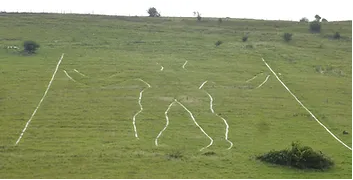
Turn left and follow the track, which has great views on both sides. After passing through a gate, it heads south-east. Keep on until the path runs along a row of bushes at the edge of a large field. Go through a wooden gate. The path becomes a tree-lined track and then runs alongside a wooden fence before emerging at 11th century Jevington Church. Go round the right-hand side of the church and take the path to the corner of the churchyard. Go through the gate and follow the path until it emerges at the road. Continue up alongside the road until you reach the old village pub, the Eight Bells. You are almost half-way through the walk here, so it's a perfect place to stop for a while.
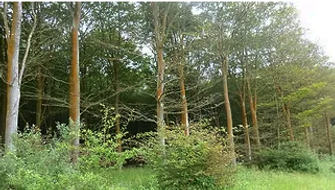
The lane leads to some steep steps up through the woods (you may need a breather half-way up) before emerging at a wall with a stile and superb views of Cuckmere Haven and Seven Sisters Country Park. Head down the field to reach Exceat, where there is a visitor centre and some toilets (see walks 1 and 33 for other routes that include Cuckmere Haven and the Seven Sisters cliffs). Cross over the road to the pavement on the other side. You have to walk along the pavement for a short stretch here, before you reach the Cuckmere Inn. The outside seating area at the back of the pub has views of the river winding its way to the sea.

From here, the final section of the walk continues along the course of the Vanguard Way. The path runs along a lovely stretch of clifftop at Seaford Head. There are views out to sea and, behind, to the Seven Sisters. You pass through the nature reserve at Hope Bottom (watch out for the rabbits here if it's approaching dusk). The path climbs to a beacon and skirts a golf course, before descending down into Seaford at Hawk's Brow. When you reach the town, head past the Martello tower on the seafront, before turning up The Causeway to reach the town centre and the station.
The inscrutable Long Man, who adorns A Trip Out’s homepage, stands astride the South Downs escarpment on Windover Hill, staring out across the Weald, his expression blank. As the Reverend A.A Evans, vicar of East Dean and Friston in the early 20th century, wrote: ‘The giant keeps his secret and from his hillside flings out a perpetual challenge’. The largest portrayal of the human form in Europe, he continues to confound all who try to decipher him. Rodney Castleden, author of The Wilmington Giant, postulated a theory that he is a representation of the sun god and part of a sacred neolithic landscape (similar to that at Avebury), which includes the nearby long barrow and another enigmatic monument, the Lewes Priory Mount (see walk 23 – a mini Silbury Hill?). However, Castleden and others have since revised their ideas due to some compelling evidence that he may have a more modern origin. The oldest drawing of the figure dates to 1710 and excavation of the brickwork that marks the outline has found that the oldest bricks date to the 1550s.


It is possible, however, that the bricks were placed there to preserve a much older carved figure. A similar figure has been discovered on 4th-century coins and a 7th-century buckle, leading weight to the theory that it might be a tribal symbol. Among the giant's mysteries are the two poles (or possibly spears) he appears to be holding. Some have suggested that this is an illusion and that he is actually guarding an entrance or gateway (but to where?). Research suggests the poles, if that is what they are, were once 3 metres taller and that the right-hand one had a diagonal line down from its top, indicating it may have been a scythe or perhaps a shepherd’s crook. There is also some evidence that there used to be a helmet or crown above the head. Whatever his origin, the sight of the giant has moved and inspired many who have crossed his path – including the artist Eric Ravilious (see pictures) – and standing within his huge frame, it's hard not to feel a sense of great timelessness when you gaze down, as he does, to the endless landscape below. KB
Walks by County
Listed by the most traversed
county for each route
Berkshire
Buckinghamshire
Henley circular
Pr. Risborough-Wendover
Tring circular
Tring-Leighton Buzzard
Cambridgeshire
Cambridge-Trumpington
Whittlesford-Wandlebury
Derbyshire
Edale-Hope
Dorset
Corfe Castle-W. Matravers
East Sussex
Ashdown Forest
Berwick circular
Berwick-Seaford
Cuckmere Haven-E'bourne
Forest Row-Eridge
Glynde-Berwick
Glynde-Seven Sisters
Isfield-Lewes
Lewes circular 1
Lewes circular 2
Lewes-Hassocks
Lewes-Rottingdean
Plumpton-Hassocks
Rye-Three Oaks
Gloucestershire
Kingham circular
Toddington-Cleeve Hill
Hertfordshire
Codicote-St Albans
Odsey-Royston
Kent
Oxfordshire
Surrey
West Sussex
Bramber-Amberley
Steyning circular
West Yorkshire
Haworth-Hebden Bridge
Wiltshire
Avebury circular
